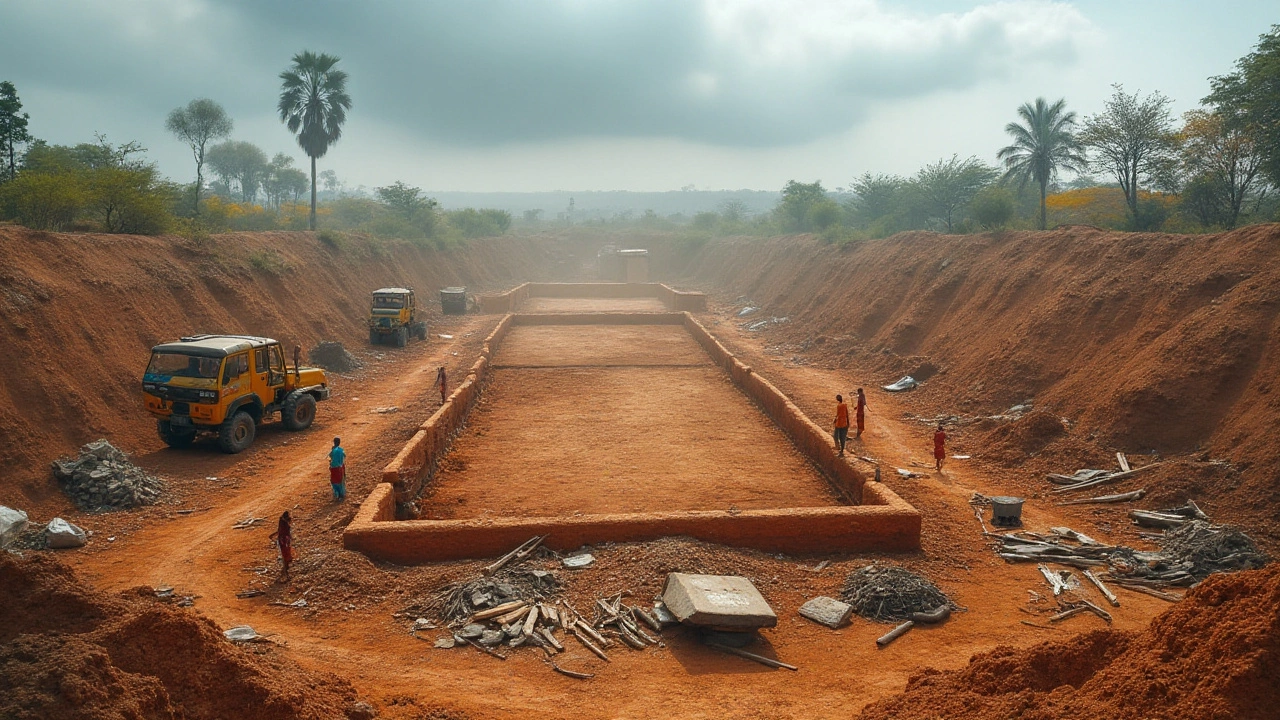Do New Construction Homes Experience Mold Issues?

When stepping into a newly constructed house, many people expect everything to be pristine and perfect. However, there is a common misunderstanding that new homes are immune to mold problems. This isn't always the case. Understanding why mold forms, even in the newest constructions, helps in taking proactive steps to address it.
Construction processes might overlook factors like moisture control, leading to unintended consequences if not managed correctly. Mold can start to grow within days when conditions are right, making it crucial for homeowners and builders to be vigilant about moisture management from the outset.
- Understanding Mold Growth in New Homes
- Common Causes of Mold in New Builds
- Prevention Strategies for Mold in New Constructions
- Identifying Mold in a Newly Built Home
- Steps to Take if Mold is Discovered
Understanding Mold Growth in New Homes
Mold might seem like an issue that plagues older homes with creaky foundations and damaged roofs, but the reality is that new builds are not exempt from this persistent problem. Moisture control during the construction process is often heralded as the key battleground where mold issues can be prevented. Mold spores, which are nearly invisible to the naked eye, exist abundantly in both indoor and outdoor environments. When they encounter moisture on building materials like wood, sheetrock, or insulation, mold finds the perfect conditions to thrive and reproduce.
For those constructing new homes, the controlled environments of construction sites are both a blessing and a curse. While it's possible to control the external variables, any oversight or mistake could result in unwanted moisture accumulation. This might include leaving building materials unprotected during unexpected rain, selecting inappropriate materials for climate conditions, or neglecting adequate ventilation in closed spaces until it’s too late. The misconception that new builds are devoid of such issues typically stems from their pristine appearance, not from any immune design feature or superior protective capability. And when mold starts to form, it can damage not only structural components but also diminish the quality of indoor air, impacting health over time.
Looking into specific facts, studies have shown that improperly managed humidity levels in a new construction can lead to mold growth within 24 to 48 hours. This quick timeframe places pressure on builders and inspectors alike as any delay in addressing moisture or ventilation problems opens the door to possible mold infestations. Builders today are more aware than ever that neglecting these risks could lead to costly repairs and tarnished reputations. A proactive approach often involves using moisture-resistant materials and monitoring construction timelines meticulously to reduce exposure to wet conditions. Of course, nature can be unpredictable, and with changing weather patterns, construction sites can face hurdles such as unexpected rainfall or flooding, making these preventive steps even more crucial.
"Even in brand new homes, mold can be an invisible but severe threat if moisture is not properly managed," remarks Dr. Jill Amstadter, an expert in environmental hazards. Her research underscores the need for developers to implement and maintain robust moisture control systems before, during, and after construction.
The adoption of advanced strategies like closed-cell spray foam and weather-resistant barriers can be instrumental in deterring mold before it starts. Some construction experts also recommend mold-resistant drywall and coatings that further reduce vulnerability to moisture intrusion. Builders who are proactive in addressing these potential sources of moisture not only enhance the longevity of the structure but also protect the health of future occupants.
Mold growth in new homes isn't simply about building materials or oversight; it is a multifaceted issue that requires attention to detail and an understanding of complex environmental factors. With the right planning, execution, and materials, it is entirely possible to minimize the risks and create a safe, enduring home free of mold-related concerns. In an age where health-conscious living is paramount, it's essential for homeowners and builders alike to be informed and vigilant.
Common Causes of Mold in New Builds
When you think about mold in new builds, it's often surprising to learn how many factors play a role. While it’s true that a new home might not have the decades of wear and water exposure that older homes do, several subtle issues can still open the door to mold. One major factor is moisture, an inevitable byproduct of the building process itself. Freshly poured concrete, adhesives used in insulation and drywall, and water based paints all contribute to a significant amount of residual moisture. If this moisture isn’t properly managed through adequate ventilation and dehumidification, it can become a breeding ground for mold spores looking for a place to call home.
Choosing the right materials makes a difference too. While you might think all new materials would be free from defect, some can actually encourage mold if improperly selected. For instance, using porous materials like untreated wood in areas prone to humidity can lead to early mold growth, undermining the integrity of a new construction. Moreover, construction delays can sometimes keep homes open to the elements longer than planned, leading to rain or dampness seeping in before walls are sealed off. This often unnoticed exposure turns into a prime opportunity for mold to thrive behind walls where it often goes unnoticed.
Inadequate ventilation is another offender. With a strong focus on energy efficiency in many new builds, homes are often built much more airtight than before. While this offers excellent insulation benefits, it can inadvertently trap moisture indoors, creating a perfect environment for mold. Effective ventilation systems are crucial in these situations, helping to move moist air out and reduce the likelihood of condensation building up in unseen places. An expert in home construction once warned, "If you tighten the envelope of the house, you're tightening your airflow, and without proper ventilation planning, that tightness can trap moisture."
Quality of workmanship can’t be overlooked either. Even the best materials and plans can fall prey to poor construction practices. Whether it's improper sealing of windows and doors, which can let water seep into walls, or plumbing that's not securely fitted leading to leaks, small mistakes during the building process can have outsized consequences later. For example, misapplied flashing around the roof and windows can channel water that manages to infiltrate, rather than deflect it, leading to hidden mold growth that can be very costly to address once detected.
Finally, it's worth mentioning that improper site grading can lead to water pooling around the foundation of a home, which in turn can seep into the basement or crawl space, areas highly susceptible to mold. This underscores how critical it is to establish good water management practices from the beginning, diverting water away from the home with proper landscape grading and gutter systems. Considering how integrated these factors are, it's clear that understanding and managing moisture, material selection, and ventilation are pivotal in maintaining a mold-free new home environment.
"The integrity of your new build depends not just on the materials and designs, but on understanding the environment it's built in and how to mitigate potential mold risks from the onset," advises a senior contractor with decades of experience in residential construction.

Prevention Strategies for Mold in New Constructions
When it comes to mold, prevention is indeed better than cure, especially in new builds. A crucial initiative during the construction phase is ensuring that every aspect of the design and build strategy incorporates moisture management. Builders often inadvertently create environments that foster mold growth by overlooking critical construction aspects. Utilizing moisture-resistant materials can dramatically reduce the risk. Vapor barriers and water-resistant drywall, for instance, are excellent preventive elements. It's imperative to install these materials the right way, as improper installation can void their effectiveness.
Ventilation plays a pivotal role, too. Ensuring that the building is well-ventilated helps in naturally managing humidity levels, a key ingredient for mold growth. HVAC systems, when used correctly, regulate indoor climates efficiently. Additionally, installing exhaust fans in areas prone to moisture, like bathrooms and kitchens, helps whisk away moist air, reducing mold risks significantly. The continuous exchange of fresh air not only improves air quality but also keeps mold fears at bay.
Site inspections shouldn't be a one-time affair. It's imperative to conduct regular and thorough checks during and after construction. Look out for any signs of water leaks or condensation, which are precursors to mold. Training the construction crew to identify potential water intrusion points is equally vital. Addressing these concerns immediately can save time, energy, and resources later. Moreover, it teaches the crew to remain vigilant for any tell-tale signs of water intrusion, thereby fostering a culture of proactive prevention.
According to the Environmental Protection Agency, “Control moisture to prevent mold growth.” This statement emphasizes the need for vigilant moisture management throughout a home's lifecycle, beginning at construction.In areas where rainfall is frequent, ensuring proper drainage systems around your foundation is non-negotiable. These systems direct water away from critical areas, minimizing the potential for unwelcome moisture to settle and invite mold growth. Properly graded landscapes reduce water accumulation near or within the foundation walls.
Lastly, communication is key. Homeowners should be educated by builders on the importance of moisture management and ventilation. Making sure new owners understand their HVAC systems and how to use ventilation correctly ensures long-term maintenance of the home’s healthy atmosphere. This collaborative approach ensures that not only are homes built mold-resistant, they remain so over their lifespan. Sharing information on dehumidifiers, for instance, can be beneficial in certain climates where ambient air moisture is consistently high.
Mold prevention, especially in new constructions, requires a holistic approach involving design, materials, and education. By weaving these elements cohesively into the construction process, one can significantly reduce the likelihood of mold, fostering healthier living environments from the ground up. Taking these lessons to heart upfront not only safeguards the structural integrity of the home but also the health of its inhabitants.
Identifying Mold in a Newly Built Home
Walking into a new house, the scent of fresh paint can mask the early signs of mold growth. Mold isn't shy, and it can manifest in visible patches or — more insidiously — in hidden spots. The first sign many people notice is often a musty, earthy odor that lingers even after rooms are ventilated. This smell is a red flag that shouldn’t be ignored, as it might indicate mold that’s growing out of sight. Finding the source of the smell can be the difference between a quick fix and a major renovation. Keep in mind that new homes might have concealed spaces where mold can thrive, under the floors or within the walls, unnoticed until it’s a big problem.
Visible signs are slightly easier to catch, as mold might appear as discoloration on walls, ceilings, or even on furniture and appliances. While mold comes in a variety of colors, it is famously recognized by its gray, green, or black patches. It often appears spotty or like a spreading stain. However, not every stain is mold, so it’s advisable to seek a professional evaluation if there is any suspicion. Interestingly, mold can also look like a simple watermark, leading people to overlook it until it spreads more widely. An essential step is to check places prone to moisture. Newly built homes often have areas that need time to dry completely, including basements, crawl spaces, and attics.
Another effective method for discovering mold is through humidity checks. Mold loves moisture, so it tends to flourish in environments with over 60% humidity. Investing in a good quality hygrometer can help keep tabs on this vital parameter. High humidity levels combined with poor ventilation create ideal mold conditions.
Renowned mold specialist Dr. Jane Rogers once said, "The nursery rhyme 'Rain, rain, go away' should be modified to 'Humidity, humidity, don't ever stay' to emphasize its importance in mold prevention."Regularly measuring and maintaining your home's humidity can prevent these issues before they balloon into a bigger problem. Addressing leaks or persistent dampness promptly is another prudent practice.
For those who prefer a technical approach, mold testing kits are available. While these kits can provide immediate results, it is important to interpret them correctly. Professional mold inspectors utilize specialized equipment and can offer thorough insights that a layperson might not pick up on. These tests can indicate mold presence but may not pinpoint the exact location if the mold is hidden. This makes professional inspection even more valuable, particularly when considering potential health risks and the investment of a new home. Mold should never be underestimated. Questions about air quality often arise when a new build is suspected of harboring mold. Many homeowners opt to have indoor air quality tests conducted to uncover any home air contamination.

Steps to Take if Mold is Discovered
Finding mold in your new build might initially seem like a daunting challenge, but with the right approach and quick actions, it can be effectively managed. The first step is to assess the extent of the mold problem. While small patches might look harmless, they can be indicative of deeper issues. It’s important to understand that mold spores are always present in the air, both indoors and outdoors, but they only become a problem when they find the right environment to grow, which is often damp and warm. This initial stage requires careful visual inspection and sometimes even professional testing to identify the type and spread of mold.
Once you've confirmed the presence of mold, it's crucial to identify and eliminate the source of moisture that is feeding it. Common culprits include leaks in plumbing systems, poor ventilation in bathrooms and kitchens, or even a leaking roof. Addressing these sources is imperative because merely removing the surface mold without fixing the underlying moisture issue will lead to a recurring problem. Engaging a professional to handle mold infestation and repair leaks is often recommended because they have the tools and expertise to ensure no residual mold remains.
"Mold problems only grow worse with time. Tackling the issue early not only helps preserve the integrity of your home but also safeguards your health," says Dr. Elaine Herman, an environmental consultant with over twenty years of experience in air quality management.
Next, consider the mold removal process itself. Small mold issues can sometimes be handled with DIY techniques using commercial cleaning products or household solutions like vinegar or baking soda. However, safety should be your primary concern. Wear protective gear, including masks and gloves, to prevent inhalation and direct contact with mold spores. For more extensive infestations, particularly those affecting your HVAC system or hidden behind walls, professional remediation services should be sought. These professionals utilize specialized equipment such as air scrubbers and HEPA vacuums to ensure the mold is entirely removed.
Prevention after remediation is just as important. Implement zoning strategies within your new build to control humidity levels. This can include installing dehumidifiers and exhaust fans in areas that are prone to moisture like basements or bathrooms. Regular maintenance checks for leaks and promptly addressing any signs of water intrusion will significantly mitigate the possibility of mold returning. Also, applying mold-resistant paint and materials in vulnerable areas can add an extra layer of protection against future mold growth.
| Common Mold Locations | Preventive Measures |
|---|---|
| Bathrooms | Install exhaust fans; Use mold-resistant paint |
| Kitchens | Ensure proper ventilation; Regularly clean sink and faucet areas |
| Basements | Use dehumidifiers; Regularly check for groundwater seepage |
While the discovery of mold in your new home can be startling, it also serves as a crucial reminder of the importance of regular home maintenance and vigilance against moisture intrusion. By following these steps, you can address and eliminate the mold effectively, ensuring a safe and healthy home environment for years to come.

